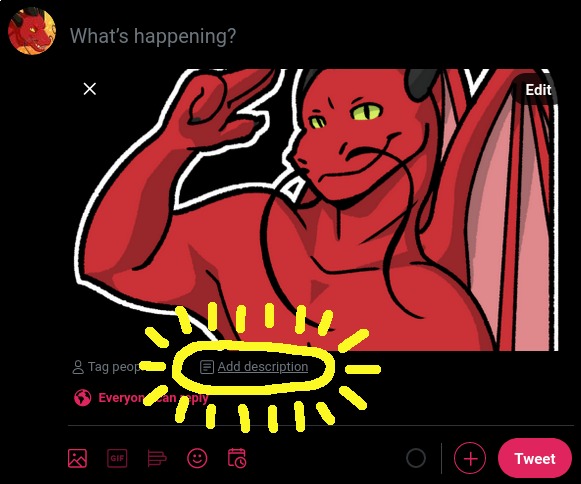Edit (late 2023): Most of this is pretty out of date; the main rant I would now put here is maybe… can we just stop using Twitter now? But some of this may apply to other social media platforms or just be useful to think about in other social media.
A small collection of minirants about the social media platform.
Please add alt text to your images
You know that “add description” link when you upload an image?
This is me encouraging you to click it and write a short description of your image. This is really helpful to people browsing Twitter who are vision-impaired and either cannot view your image, or have difficulty doing so. (Maybe worth repeating: viewers don’t have to be completely blind to benefit from alt-text, so the number of such people might be higher than you think.) With good alt-text, they’ll still be able to get a sense of what your tweet is about (typically by having their computer read the alt-text aloud, but this can happen in a variety of ways). Alt-texts: The Ultimate Guide is a good guide on how to write these things; it’s by an author who has vision impairment and depends on alt-texts daily.
In the same vein, avoid tweeting screencaps of text if you can, or at least provide links to places where you can read the text outside an image. If you occasionally feel the need to tweet something really long, you can use a service like TwitLonger, or just dump your text on Pastebin or a similar tool. If you do this often, maybe Twitter isn’t the best medium… have you considered starting a blog?
Abusing Unicode characters
While we’re talking about accessibility: Twitter doesn’t support text formatting like bolding or italicizing part of your tweet or display name. Some people get around this by using funky Unicode characters, like 𝘁𝗵𝗶𝘀 for bolding, for example. If you’ve ever used these characters, I encourage you to listen to this clip about how assistive technologies handle them:
You 𝘵𝘩𝘪𝘯𝘬 it's 𝒸𝓊𝓉ℯ to 𝘄𝗿𝗶𝘁𝗲 your tweets and usernames 𝖙𝖍𝖎𝖘 𝖜𝖆𝖞. But have you 𝙡𝙞𝙨𝙩𝙚𝙣𝙚𝙙 to what it 𝘴𝘰𝘶𝘯𝘥𝘴 𝘭𝘪𝘬𝘦 with assistive technologies like 𝓥𝓸𝓲𝓬𝓮𝓞𝓿𝓮𝓻? pic.twitter.com/CywCf1b3Lm
— Kent C. Dodds (@kentcdodds) January 9, 2019
In case you can’t listen to it, the italicized word “think” is read loud as “mathematical sans serif italic small tee mathematical sans serif italic small aitch mathematical sans serif italic small one mathematical sans serif italic small n(?) mathematical sans serif italic small kay”. The other formatted words are handled similarly. This isn’t a bug. That’s what those characters mean. They’re meant to be used individually for variables in mathematical contexts, where the fact that they are bolded is crucial for interpreting them correctly. They aren’t meant to be used for emphasizing words, and people using screen readers will likely have trouble understanding them.
There may be times when formatting a word in a particular way is really important to the spirit of the tweet for some reason, and it’s unfortunate that Twitter doesn’t offer any better choices (not supporting formatting is a tradeoff, like everything else in software), so I won’t ask for everybody to stop using these in every scenario. Just be aware of the downsides when you do, and consider alternative methods of emphasis, such as:
- UPPERCASE TEXT
- old school *asterisks*
- 👏 clap 👏 emoji 👏, ✨ sparkles ✨, etc. (in heavy moderation, they don’t screen read well either)
- consulting a thesaurus for stronger words
- putting the text you need to format somewhere other than Twitter
Quote-retweets
On a completely different note, it’s pretty common for people to quote-retweet bad takes and explain why they’re bad. I’m not a big fan of this practice. It’s hard to know exactly how Twitter’s algorithm works, but it’s pretty plausible that quote tweets are considered engagement and will cause the tweet you’re quoting to be shown more to other people, which isn’t what you want. (This is one case where screencaps of tweets might be better than the alternative.) Generally, I would advise only quote-retweeting things you agree with.
A reminder that may not be obvious: amplification on social networks has monetary value. Twitter’s algorithm counts it as engagement even if you shared a tweet to criticize it or mock it, and uses that signal to amplify the tweet further. Only RT what you would pay to promote.
— Anil Dash (@anildash) March 1, 2020
Even if this isn’t how Twitter works, now or in the future, paying the bad take and its poster any kind of attention sometimes still benefits them, or is precisely what they’re going for.
Maybe we can make a pact...you and me and everyone who sees this...if someone is being awful attention on the internet...can we...can we ignore them?
— Hank Green (@hankgreen) March 18, 2021
Because, like, they want us to get mad...it makes them happy...it makes them money.
Have you considered instead:
- simply tweeting the correct take?
- not engaging at all?
